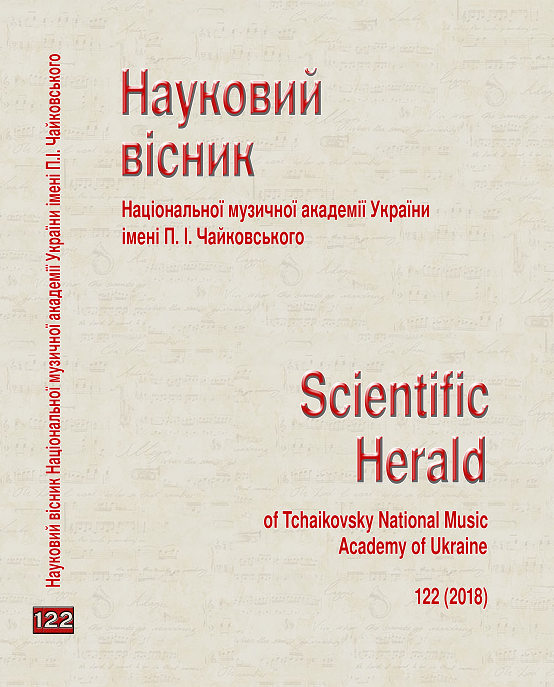The specificity of the double simple imitation and its role in the dramaturgy of the Renaissance epoch musical works
DOI:
https://doi.org/10.31318/2522-4190.2018.122.141809Keywords:
double simple imitation, convertible counterpoint, dramaturgy, musical form, RenaissanceAbstract
Relevance of the study. Dramaturgy of the vocal works from the Renaissance epoch, connected to the application of the specific ways of counterpoint work, thus far hasn’t been studied more thoroughly. Yet, the manifestation of some of the dramatic principles can also be noticed in music of this period. It is specially relevant at presentation of the two themes in simultaneous sounding. In that context, the specificities of musical dramaturgy realization by use of the simple imitation are little known. Main objective of the study is to light up the distinctiveness of the double simple imitation in the austere style music and to examine its reference to convertible counterpoint. On the other side, the influence of the counterpoint technique on the dramaturgy of Renaissance musical work will be opened. Methodology is based on the examples analysis from Palestrina creative work. How the study was done. In chosen analytical specimens, the ways of counterpoint work was identified and defined along with the definiteness of their dramaturgic function in the context entirety.
Results and conclusions. The double simple imitation leads to various possibilities of the imitation voices combination, specially in situations when the themes length is dissimilar. The convertible counterpoint, which then appears might be interpreted by methods used at unimitated polyphony. On the other side, such application of the polythematic imitation might be in function of the musical form dramaturgy. Through the various spatial changes of the thematic material within composition entirety specific section, the clear separation of thematic material occurs in relation to the other, monothematic sections; it is experienced as the focus of composition. By beforehand planned way of work with the themes, the clear movement architectonics is created. Practical significance. The work shows the way of the simple imitation interpretation based on two themes. Additionally, this research opens up the possibility of dramaturgy use as analytical practice instrument and also in vocal works of the old counterpoint masters.
Downloads
References
Bogatyrev, S. (1948), Double Canon. Muzgiz, Moscow, 128 p. [in Russian].
Liashenko, H. (1976), Fugue and Its Role in the Dramatic Compositions of Nonpolyphonic Forms, Muzychna Ukrajina, Kyiv, 208 p. [in Ukrainian].
Simakova, N. (2002), Counterpoint in the Strict Style and Fugue. History. Theory. Practice. Vol. 1, Kompozitor, Moscow, 528 p. [in Russian].
Taneev, S. (1959), Convertible Counterpoint in the Strict Style, Gosudarstvennoe muzykalnoe izdatelstvo, Moscow, 383 p. [in Russian].
Taneev, S. (1929), Doctrine of the Canon, Muzsektor Gosizdata, Moscow, 195 p. [in Russian].
Marinković, S. (2007), “The Term Dramaturgy of Form in Analytical Practice”, Muzička teorija i analiza 4 [Music Theory and Analysis 4], Fakultet muzičke umetnosti, Beograd, pp. 36-46. [in Serbian].
Downloads
Published
How to Cite
Issue
Section
License
Our journal abides by the CREATIVE COMMONS copyright rights and permissions for open access journals.
Authors, who are published in this journal, agree to the following conditions:
The authors reserve the right to authorship of the work and pass the first publication right of this work to the journal under the terms of a Creative Commons Attribution License, which allows others to freely distribute the published research with the obligatory reference to the authors of the original work and the first publication of the work in this journal.
The authors have the right to conclude separate supplement agreements that relate to non-exclusive work distribution in the form in which it has been published by the journal (for example, to upload the work to the online storage of the journal or publish it as part of a monograph), provided that the reference to the first publication of the work in this journal is included.




